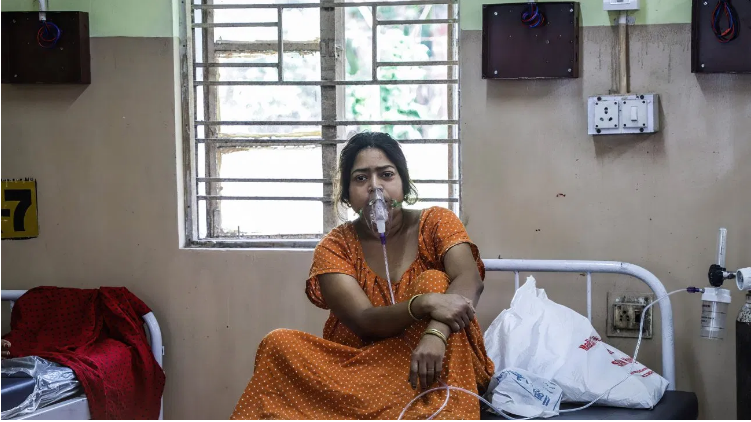Even as India struggles to contain a deadly surge of COVID-19, doctors are now reporting cases of a rare infection called the “black fungus,” occurring among people recovering from the disease.
The fungal infection is increasingly being seen in vulnerable patients in India, as the country’s health system struggles to save lives during the pandemic.
According to the Centers for Disease Control and Prevention (CDC)Trusted Source, this black fungus infection is called mucormycosis and is caused by a group of molds called mucormycetesTrusted Source that typically live in soil and decaying organic matter.
The infection can be life threatening and has a mortality rate between 46–96 percent depending on severity.
What to know about mucormycosis
“Mucormycosis is a rare, invasive, fungal opportunistic infection that causes serious, sometimes fatal disease,” Dr. K.C. Rondello, epidemiologist and special adviser to the Office of University Health and Wellness at Adelphi University, told Healthline.
He explained that those most at risk for mucormycosis have compromised immune systems that make them susceptible to fungal and other opportunistic infections.
“This includes individuals who are currently fighting or have recently recovered from COVID-19 disease,” said Rondello.
Over the last 10 years, doctors have only seen a handful of mucormycosis cases in India, reported USA Today.
This past month, however, tens of thousands of cases have been reported, Dr. Bhakti Hansoti, associate professor in the department of emergency medicine and international health at Johns Hopkins Bloomberg School of Public Health, told USA today.
“We’ve seen this skyrocket in recent weeks,” she said. “It consumes a lot of resources especially during this pandemic right now in India where healthcare resources are stretched at the limit.”
Symptoms of mucormycosis
Mucormycosis can affect different parts of the body, showing different sets of symptoms, according to the CDCTrusted Source.
If the infection grows in the sinuses and brain (rhinocerebral mucormycosisTrusted Source), symptoms include fever, one-sided facial swelling, headache, and nasal or sinus congestion.
If your lungs are affected by the fungus, you can experience cough, chest pain, and shortness of breath.
When mucormycosis attacks the digestive system, you may experience abdominal pain, nausea and vomiting, and gastrointestinal bleeding.
“It’s an environmental mold, which once it infects you, is very morbid and has a high mortality,” said Dr. Eric Cioe-Peña, director of Global Health at Northwell Health in New York. “Because the infection is so rare, the exact mortality rate isn’t clear. But researchers estimate that overall, 54 percent of people with mucormycosis die.”
He added that people with COVID-19 theoretically could be at higher risk due to an immune reaction, or inflammation locally in the sinus tract. Cioe-Peña confirmed the fungus isn’t normally contagious.
According to Bhayani, you can contract the fungus by inhaling the mold spores or when you come into contact with them in things like soil, rotting produce or bread, or compost piles.
“Mucormycosis is normally not spread person to person, but is found in the environment,” he said. “However, due to the level of spread, it’s too early to say how this is spreading.”
Who’s at risk and how is mucormycosis treated?
According to researchersTrusted Source, while mucormycosis is comparatively rare, increased use of chemotherapy and steroid drugs — like those used to treat some COVID-19 patients — may be increasing its frequency.
In a recent small studyTrusted Source, scientists concluded that COVID-19 patients with diabetes that were treated with steroid drugs had a significantly increased risk of experiencing fungal infections like mucormycosis.
According to Dr. Nikhil Bhayani, infectious disease expert at Texas Health Resources, mucormycosis can be treated with antifungal agents like amphotericin B, isavuconazole, and posaconazole.
“In severe cases, your doctor may recommend surgery to remove infected or dead tissue to keep the fungus from spreading,” he said. “This might include removing parts of your nose or eyes. This could be disfiguring, but it’s crucial to treat this life threatening infection.”
People with COVID-19 at increased risk of many ‘opportunistic infections’
Dr. Rondello explained that individuals fighting a “significant infection” like COVID-19 are more susceptible to developing opportunistic infections as their immune systems are busy fighting the SARS-CoV-2 virus.
“Opportunistic infections can be caused by fungi, bacteria, viruses, even parasites,” he said.
He said other common fungal infections can include:
- Candidiasis, a fungal infection caused by a yeast (a type of fungus) called Candida.
- Histoplasmosis, a disease caused by a fungus (or mold) called histoplasma. This fungus is common in the eastern and central United States.
- Aspergillosis, caused by aspergillus, a common mold found in buildings and outdoors.
“There is limited evidence that patients with COVID-19 are vulnerable to developing pulmonary (lung) aspergillosis,” said Dr. Rondello.
Source: https://www.healthline.com/health-news/black-fungus-is-appearing-in-people-with-covid-19-what-to-know#Aspergillosis-infection-of-particular-concern






